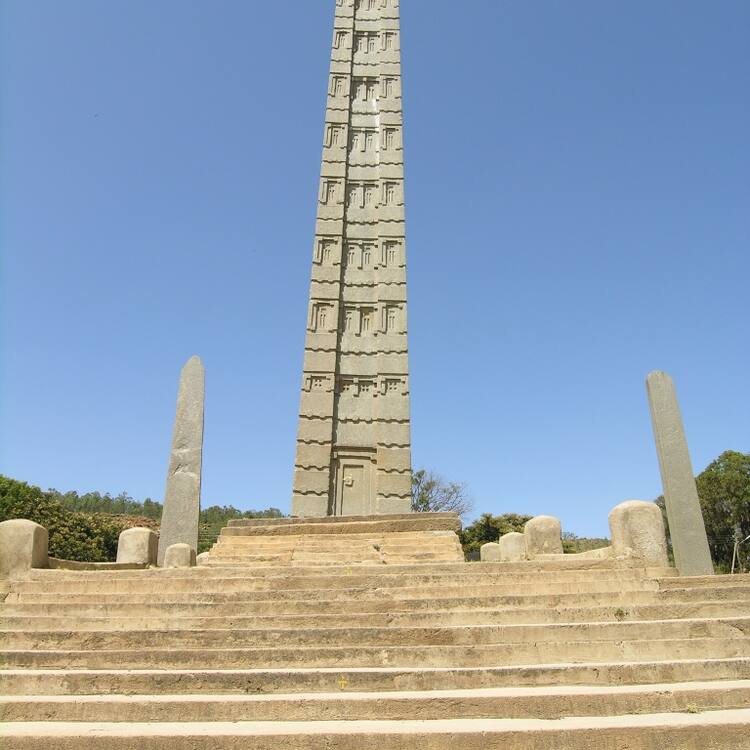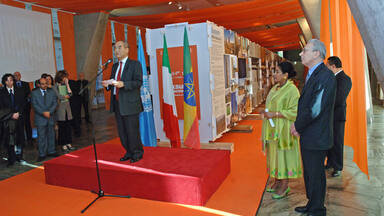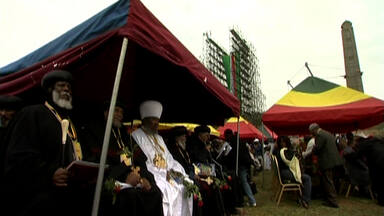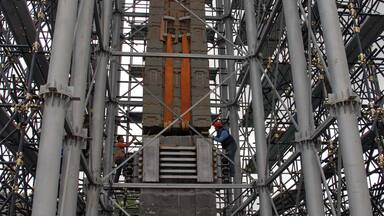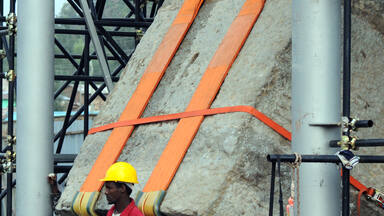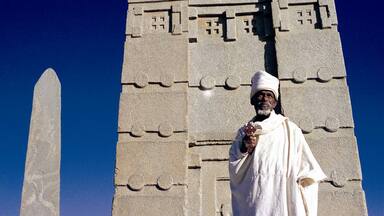Aksum
Aksum
The ruins of the ancient city of Aksum are found close to Ethiopia's northern border. They mark the location of the heart of ancient Ethiopia, when the Kingdom of Aksum was the most powerful state between the Eastern Roman Empire and Persia. The massive ruins, dating from between the 1st and the 13th century A.D., include monolithic obelisks, giant stelae, royal tombs and the ruins of ancient castles. Long after its political decline in the 10th century, Ethiopian emperors continued to be crowned in Aksum.
Description is available under license CC-BY-SA IGO 3.0
Axoum
Près de la frontière nord de l'Éthiopie, les ruines de la ville ancienne d'Axoum marquent l'emplacement du cœur de l'Éthiopie antique, lorsque le royaume d'Axoum était l'État le plus puissant entre l'Empire romain d'Orient et la Perse. Les ruines massives, qui datent du Ier au XIIIe siècle, comprennent des obélisques monolithiques, des stèles géantes, des tombes royales et les ruines de châteaux anciens. Longtemps après son déclin politique vers le Xe siècle, les empereurs d'Éthiopie vinrent se faire couronner dans cette ville.
Description is available under license CC-BY-SA IGO 3.0
أكسوم
تقع آثار مدينة أكسوم القديمة على مقربةٍ من حدود إثيوبيا الشماليّة وفي قلب إثيوبيا القديمة يوم كانت مملكة أكسوم الدولة الأعظم بين الإمبراطوريّة الرومانيّة في الشرق وبلاد فارس. وتشمل الآثار الكثيرة، التي تعود إلى الحقبة الممتدة من القرن الأوّل إلى القرن الثالث عشر، نصباً عموديّة منحوتة من حجرٍ واحد ومسلاّت عملاقة وقبورا ملكيّة وآثار قصور قديمة. وبعد وقت طويلٍ على تآكل سلطة إثيوبيا السياسيّة قرابة القرن العاشر، استمر الأباطرة يتوافدون إلى أكسوم لتنصيبهم فيها.
source: UNESCO/CPE
Description is available under license CC-BY-SA IGO 3.0
阿克苏姆考古遗址
阿克苏姆古城遗址位于埃塞俄比亚北部边境附近。这里曾是古代埃塞俄比亚的心脏地带,当时的阿克苏姆王国(the Kingdom of Aksum)是东罗马帝国和波斯帝国之间最强大的国家。大量的遗迹都可追溯到公元1世纪至13世纪之间,包括完整的方尖碑、大型石柱、皇家墓地和古代城堡遗迹。公元10世纪政治衰退很久以后,埃塞俄比亚皇帝的加冕仪式仍然在阿克苏姆举行。
source: UNESCO/CPE
Description is available under license CC-BY-SA IGO 3.0
Древний город Аксум
Руины древнего города Аксум найдены вблизи северной границы Эфиопии. Они отмечают местонахождение ядра древней Эфиопии, когда царство Аксум было сильнейшим государством древнего мира, наряду с Восточной Римской империей и Персией. Массивные руины, относящиеся к периоду I-XIII вв., включают монолитные обелиски, огромную стелу, царские гробницы и развалины древних замков. Долгое время после политического упадка в Х в. императоры Эфиопии продолжали короноваться в Аксуме.
source: UNESCO/CPE
Description is available under license CC-BY-SA IGO 3.0
Axum
Ubicadas cerca de la frontera septentrional de Etiopía, las ruinas de la ciudad de Axum señalan el emplazamiento del centro del poder etíope en la Antigüedad, cuando el reino del mismo nombre era el más poderoso de los estados situados entre el Imperio Romano de Oriente y Persia. Las ruinas colosales de Axum datan de los siglos I a XIII y comprenden obeliscos monolíticos, estelas gigantescas, sepulturas reales y vestigios de antiguos castillos. Mucho tiempo después de que se consumara la decadencia política de la ciudad (hacia el siglo X), las ceremonias de coronación de los emperadores etíopes se seguían celebrando en esta ciudad.
source: UNESCO/CPE
Description is available under license CC-BY-SA IGO 3.0
アクスム
source: NFUAJ
Aksum
Aksum ontstond enkele eeuwen voor de geboorte van Christus, als de hoofdstad van een staat die handel dreef met het oude Griekenland, Egypte en Azië. De ruïnes van de oude stad liggen dichtbij de noordelijke grens van Ethiopië. Ze markeren het hart van het oude Ethiopië, toen het Koninkrijk van Aksum de machtigste staat was tussen het Oost-Romeinse Rijk en Perzië. De massieve ruïnes dateren van tussen de 1e en 13e eeuw na Christus en bestaan uit monolithische obelisken, reusachtige stèles, koninklijke graven en ruïnes van oude kastelen. Lang na het politieke verval van Aksum in de 10e eeuw, werden er nog Ethiopische keizers gekroond.
Source: unesco.nl
Outstanding Universal Value
Brief Synthesis
Situated in the highlands of northern Ethiopia, Aksum symbolizes the wealth and importance of the civilization of the ancient Aksumite kingdom, which lasted from the 1st to the 8th centuries AD. The kingdom was at the crossroads of the three continents: Africa, Arabia and the Greco-Roman World, and was the most powerful state between the Eastern Roman Empire and Persia. In command of the ivory trade with Sudan, its fleets controlled the Red Sea trade through the port of Adulis and the inland routes of north eastern Africa.
The ruins of the ancient Aksumite Civilization covered a wide area in the Tigray Plateau. The most impressive monuments are the monolithic obelisks, royal tombs and the palace ruins dating to the 6th and 7th centuries AD.
Several stelae survive in the town of Aksum dating between the 3rd and 4th centuries AD. The largest standing obelisk rises to a height of over 23 meters and is exquisitely carved to represent a nine-storey building of the Aksumites. It stands at the entrance of the main stelae area. The largest obelisk of some 33 meters long lies where it fell, perhaps during the process of erection. It is possibly the largest monolithic stele that ancient human beings ever attempted to erect.
A series of inscription on stone tablets have proved to be of immense importance to historians of the ancient world. Some of them include trilingual text in Greek, Sabaean and Ge'ez (Classical Ethiopian), inscribed by King Ezana in the 4th century AD.
The introduction of Christianity in the 4th century AD resulted in the building of churches, such as Saint Mary of Zion, rebuilt in the Gondarian period, in the 17th century AD, which is believed to hold the Ark of the Covenant.
Criterion (i): The exquisitely carved monolithic stelae dating from the 3rd and 4th centuries AD are unique masterpieces of human creative genius.
Criterion (iv): The urban ensemble of obelisks, royal tombs and churches constitute a major development in the cultural domain reflecting the wealth and power of the Aksumite Civilization of the first millennium AD.
Integrity
The boundaries of the property, which encompass the entire area of ancient Aksum town, need to be adequately delineated and approved by the Committee.
One obelisk, removed from the site and taken to Rome as a war trophy during the Italian occupation, was returned to Aksum in 2005 and re-erected in in 2008.
Furthermore, at the time of inscription, it was noted that small, modern houses were built over most of the site, obscuring the majority of the underground Aksumite structures. Some of them still remain covered by modern houses. In 2011, the construction of a new museum began in the main Stelae Field and, unless amended, the height of the museum will have a highly negative visual impact on the property. Flooding has also become a major problem in the 4th century AD Tomb of the Brick Arches and other monuments.
For the reasons mentioned above, the integrity of the property remains vulnerable.
Authenticity
The authenticity of the obelisks, tombs and other monuments remain intact, although they are vulnerable due to lack of conservation. However, the authenticity of the whole property in terms of its ability to convey the scope and extent of ancient Aksum and its value is still vulnerable to lack of documentation, delineation and lack of planning controls. The monuments need to be related to the overall city plan, in spatial terms.
Protection and Management Requirements
The city of Aksum was put under the jurisdiction and protection of the National Antiquities Authority in 1958. No special legal framework is provided to protect the Obelisks of Aksum, except the general law, Proclamation No. 209/2000, which also established the institution in charge, the Authority for Research and Conservation of Cultural Heritage (ARCCH).
The property is managed at three levels – the site; the region; and the Federal administration. ARCCH prepared a proclamation that mapped and identified the precise area to be protected with local site authorities. It is reviewing the components and may wish to suggest changes to the number and/or size of the property.
The boundary and the property’s management plan are not yet established. There is a need to submit an up-dated map of the property to clearly indicate the boundary, to produce and submit a management plan and to delineate and submit a buffer zone. There is also a need for adequate legal protection to be put in place.
